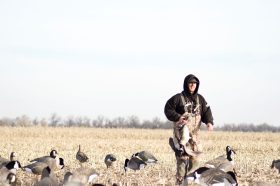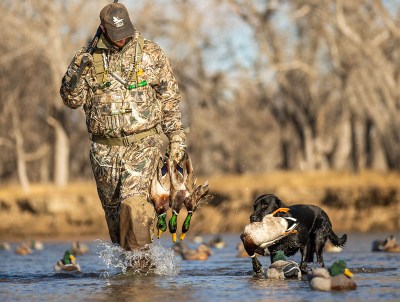
Is the USFWS Underestimating the Number of Duck Hunters in the U.S.?
There’s a disparity between duck hunter numbers and the amount of duck stamps sold each year. Something doesn’t add up.
The number of actual duck hunters versus those that buy duck stamps doesn’t add up. Joe Genzel
Ask any duck hunter, and they’ll say they’re seeing more pressure in the field over recent years. But federal data indicate there actually aren’t more waterfowlers buying duck stamps. So, what gives?
From 2011 to 2018, the U.S. Fish and Wildlife Service (USFWS) sold an average of 1.5 to 1.7 million federal duck stamps a year. But according to its annual harvest reports (HIP), duck hunter numbers have been much lower, fluctuating between 800,000 to 1 million over the last decade. That means there are potentially 500,000 to 700,000 more stamps sold each season than there are hunters—staggering.
The USFWS attributes the extra sales to collectors, hunters who buy multiple stamps, birders, outdoor enthusiasts, and supporters of National Wildlife Refuges. But it remains a mystery as to who definitively purchases these stamps because the USFWS doesn’t have any hard data on individual sales.
So, who is buying all these extra stamps? Does the disparity in stamps bought and the number of estimated duck hunters in the U.S. mean there are more waterfowlers than the USFWS reports? I talked to experts in conservation and waterfowling to find out.
Why Do Duck Stamp Sales and Hunter Numbers Matter?
Duck hunters have a hard time understanding why there are so many more duck stamps bought than duck hunters. USFWS
There has been a longstanding disparity between duck stamp sales and hunter numbers, puzzling and frustrating duck hunters. The USFWS estimates that participation is trending down, but the exact decline in hunters is up for debate.
Duck stamp sales remain significantly higher than the number of U.S. duck hunters. Many waterfowlers don’t understand how there can be such a wide gap between the two estimates, especially when they see more hunters in the marsh each fall. Overcrowding has become an issue in many duck hunting locations, such as Arkansas where the state limits the number of non-residents allowed to hunt WMAs.
HIP is supposed to accurately tally the number of active duck hunters but it’s a flawed system. Coordinating data from different states to get an accurate count is impossible. Additionally, not every state has an accurate way of tracking hunter densities, making it more difficult to manage hunting pressure at public wetlands and refuges.
How Do We Start Tracking Duck Stamp Buyers?
Trends in duck stamp sales over the years. Emily Reed
According to the USFWS, in the 85 years since the duck stamp was implemented, funds from the sales have supported the conservation of 6 million acres of wetland habitat. Now, conservation groups want to target their marketing efforts to hunters and expand to photographers, birders, and conservationists to diversify funding generated by the stamp. However, without data on who is buying the stamps, their efforts are a shot in the dark.
John Denvey, the Senior Vice President of Policy for Delta Waterfowl, has been discussing the gap in active hunter data versus federal duck stamp data for most of his career. He believes implementing surveys similar to other industries would provide valuable consumer data for targeted marketing.
In March of this year, the waterfowl working group under the Association of Fish and Wildlife Agencies (AFWA) created a new task force to make recommendations for the federal duck stamp. Luke Naylor, the Waterfowl Program Coordinator for Arkansas Game and Fish Commission, says there is conversation about the feasibility of data collection through online purchasing platforms.

Naylor also states that implementing these changes will require legislative congressional action because of the way the duck stamp was originally implemented.
Duck Stamp Numbers and HIPs Don’t Match
Federal duck stamp purchases used to be the only way to track the number of active duck hunters. Joe Genzel
The Migratory Bird Hunting Stamp Act was signed in 1934, requiring all waterfowl hunters to purchase and carry a federal duck stamp. The data from the federal duck stamp purchases were used to determine how many waterfowl hunters there were across the country.
In 1998, the Migratory Bird Harvest Information Program (HIP) was implemented by each state to assess other types of migratory bird hunters, including waterfowl. HIP requires all migratory bird hunters to enroll and provide their contact information and answer questions about their hunting activity. However, HIP is a flawed system and coordination between states makes it difficult to get an accurate count of hunters.
There is a perception of inaccurate waterfowl hunter numbers because the initial HIP certification questions are only used to stratify the sample for a more in-depth survey. The national harvest survey asks hunters to maintain a voluntary hunting record throughout the season to estimate the number of active hunters and harvest of each species.
There Are Two Kinds of Hunters, and They Are Tough to Track
Duck hunter numbers are slipping, but by how much is unknown. Joe Genzel
Reports from HIP have shown a decline in active waterfowl hunters. According to the latest report for the 2019-2020 season, there were 989,500 hunters, down from 1.09 million in the previous season. This was only the third time in the past 81 years that the number of waterfowl hunters in the United States has slipped below 1 million.
The decline in hunters isn’t always felt by hunters themselves, especially as overcrowding has become an issue in many duck hunting locations. It’s possible that the decline reflects a decrease in hunting effort from casual hunters, rather than a decline in avid hunters.
The Data Doesn’t Add Up to Duck Hunting Reality
Ramsey Russell has hunted all over the world and has unique perspectives on active duck hunters. Outdoor Life
Ramsey Russell, the founder of getducks.com, believes there is a decline in hunters but that the real problem lies in hunter density and lack of access. He argues that there are too few public locations for duck hunters, making it seem like more people are taking up the sport.
Russell’s perspective should fuel efforts to conduct more surveys on the federal duck stamp in order to diversify marketing and generate more revenue for preserving wetland habitat and developing additional hunting locales.
There are concerns about the legitimacy and quality of HIP data, and efforts are being made to address data quality concerns. Brad Bortner, a retired Chief of Migratory Birds for the USFWS, is working with the Wildlife Management Institute and state agencies to develop new methods of determining the number of hunters.
There are consequences to asking more questions, as the length of time it takes for hunters to fill out surveys may become counterproductive. However, integrating social surveys into HIP and the federal duck stamp could provide valuable demographic and behavioral data for strategic marketing efforts.
More efficient and accurate data collection methods are being explored to benefit all duck hunters and preserve migratory bird habitats.

A skilled hunter, dedicated conservationist, and advocate for ethical practices. Respected in the hunting community, he balances human activity with environmental preservation.
